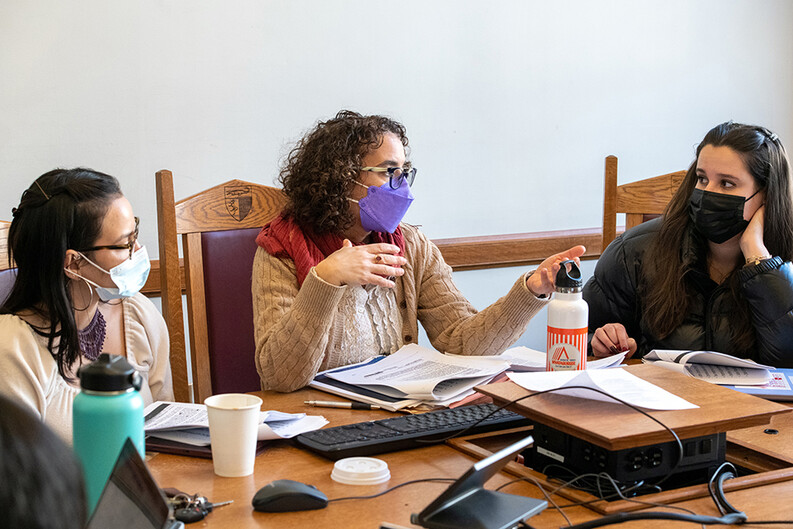Q&A: Professor Gohara on Reforms in Sentencing and Parole

Clinical Professor of Law Miriam Gohara received tenure on July 1. For 16 years, she represented death-sentenced clients in post-conviction litigation, first at the NAACP Legal Defense Fund and then as a specially designated federal public defender with the Federal Capital Habeas Project. At the Law School, she leads the Challenging Mass Incarceration Clinic (CMIC) and the Criminal Justice Advocacy Clinic (CJAC). Gohara described the work of her clinics and her research on the historical and social forces implicated in culpability and punishment.
In just the past year, the efforts of you and the CMIC and the CJAC have included representing individual clients, conducting research, testifying before the state legislature, and advocating publicly for reform. What policies and reforms do you see as being most important to the CMIC’s and CJAC’s work in the months and years ahead?
CMIC’s core principle is that just punishment should account for people’s individual contexts, vulnerabilities, and frailties as well as for their capacity for and record of rehabilitation. All the work the clinic students do is oriented toward advancing this principle. They do so by representing clients who are incarcerated or facing incarceration to persuade parole boards, prosecutors, and judges to reduce their sentences, or to sentence them to programs that will provide the treatment and support they need outside of prison. CJAC students do related policy advocacy. The clinics will litigate and advocate for sentencing reforms that invest in people’s health and well-being as the best path towards meaningful and lasting public safety. That starts with putting resources into trauma-informed mental health and substance use treatment programs in the communities most impacted by crime as well as in prisons and jails to help people heal before they return to their homes and neighborhoods.

You have argued that commutation applications allow Connecticut’s Board of Pardons and Parole to consider the track record of time spent in prison. Why should the Board take post-conviction factors into consideration?
When judges sentence people to long prison terms, they obviously have no way to know whether the people they sentence have the capacities to live law-abiding lives, serve others, and improve themselves years into their incarceration. Parole, commutation, and sentencing modification permit parole boards and judges to take a second look at people serving long prison terms to see whether they have demonstrated records of rehabilitation that warrant reducing their prison terms and giving them a chance to live safely in their communities. Time and again, our clinic work has shown that people who are sentenced to long prison terms, including life without parole, become remarkable students, teachers, mentors, and legal advocates while they are incarcerated. They often create their own opportunities and support each other in meeting educational and personal goals. Giving these people second chances to live outside of prison both recognizes their positive track records and gives them a chance to give back to their communities by using their lived experiences to help others at risk of breaking the law and ending up in prison. In that way, second chance sentencings offer a powerful means of breaking cycles of harm and incarceration.
Your practice and research touch on the relationships among victimization, incarceration, and racial disparities in both. What draws you to the intersection of those areas of interest?
Over more than two decades representing people convicted of serious crimes, I have learned that, invariably, each of them has been a victim, usually of violence, well before they hurt anyone else. My interest in the relationship between surviving crime and then later being punished for crime arises from that experience. My current research project examines how and why the politically dominant victims’ rights movement ignored the activism of African American survivors of crime, whose service in their own communities points to social investment instead of over-reliance on punishment as the path to lasting public safety for all. At the same time that the politically dominant victims’ rights movement coalesced and made policy gains nationally in the 1980s and 1990s, Black-led organizations serving survivors of crime were modeling self-help, mutual-aid, and non-law-enforcement public safety interventions. These organizations modeled their work on previous work by African American civil rights leaders such as Ida B. Wells’s anti-lynching campaigns in the late 19th and early 20th centuries, the Urban League’s efforts at meeting the needs of African Americans migrating to Northern cities from the South in the early 20th century, and the Black Panther Party for Self-Defense’s community protection work in the mid-20th century. Organizations such as Crime Survivors for Safety and Justice, Mothers in Charge, and The Movement for Black Lives carry on this work today. Had the dominant victims’ rights movement adopted the goals of the Black-led survivors’ organizations, the range of options available to all crime victims would have included anti-poverty social investments that would have ameliorated the conditions well-documented to proliferate crime, rather than the law-enforcement-centered procedural entitlements and small-bore financial compensation that the dominant movement lobbied for and that official victims’ rights bureaucracies offer survivors of crime today.


